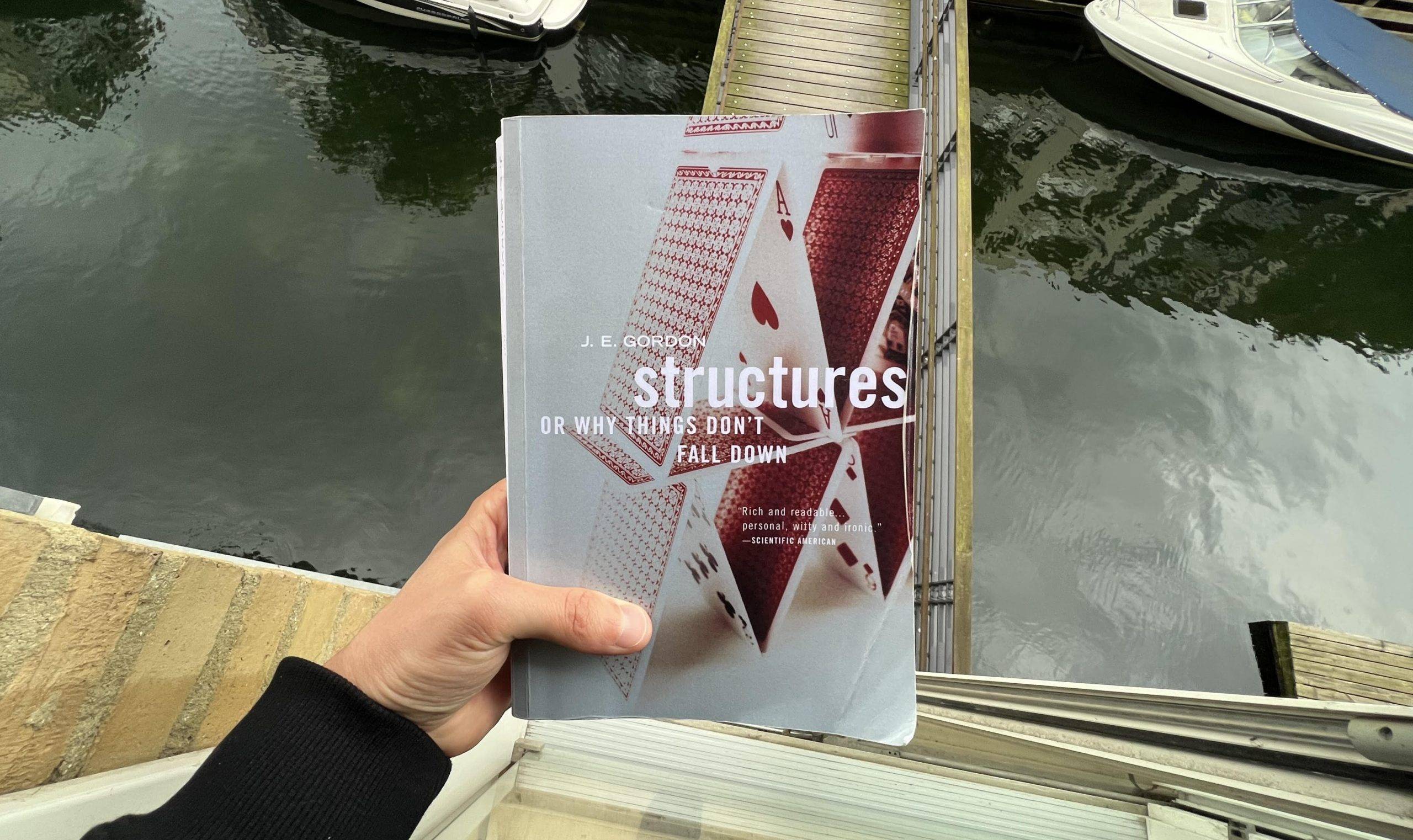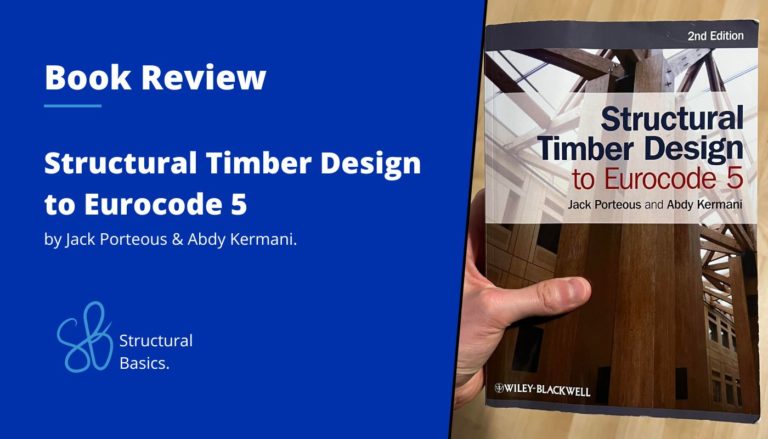Structures: Or Why Things Don’t Fall Down (J. E. Gordon) – Notes & Thoughts

This book taught me to look outside the box of normal structural engineering and see even more structures in my daily life
Table of contents
📖 The book in a few words
- The book teaches structural engineers and non-engineers the basics of structural behaviour of everyday structures and items, e.g. why bridges are safe to drive or walk on or why in the early 20th century many German fighter aircraft lost their wings in combat.
- The engineering principles are explained in a very simple and humorous way.
- Structural theory explained with real world examples.
- Another title of the book could also be The History of Structural Engineering due to the historical review of formulas, structures, scientists and engineers that contributed to modern structural engineering.
👀 Why you should read it
Structural Engineer, student or non-engineer, this book helps to understand the world we live in better. It touches base on the design principles of bridges, aeroplanes, kangaroos, ships and many other structures. This book is for you if:
- You want to understand the way forces “flow” through structures.
- You want to learn or brush up on the concepts of compression, tension, shear, torsion, fracture, stress, strength & stiffness.
- You are a structural engineer or student who wants to learn about the history of structural engineering and its forefathers.
🏗️ How it helped me understand structures better
- I learned that the basic principles of structural aeroplane and ship engineering are similar to the principles applied in buildings and bridges.
- It broadened my horizon in terms of seeing.
- It entertained me while learning about the historical development of structural engineering. How the science of elasticity evolved. What important scientists shaped the engineering of today.
🔔 My 3 favourite quotes
- Very efficient structures can be found in nature:
“The lilies of the field toil not, neither do they calculate, but they are probably excellent structures, and indeed Nature is generally a better engineer than man.” (p.60)
- Quote explaining shear stress:
“If tension is about pulling and compression is about pushing, then shear is about sliding. In other words, a shear stress measures the tendency for one part of a solid to slide past the next bit: the sort of thing which happens when you throw a pack of cards on the table or jerk the rug from under someone’s feet.” (p. 245)
- What is a beam?
“[..] that is to say, a load which acts at right angles to the length of the beam is supported without putting any longitudinal force upon whatever is supporting the beam. This is essentially what all beams are for.” (p.229)
☘️ 3 important formulas
Young’s modulus (p. 52):
\begin{equation}
E = \frac{\mbox{stress}}{\mbox{strain}} = \frac{\sigma}{\varepsilon}
\label{eq:e-modulus}
\end{equation}
Shear modulus (p.249)
\begin{equation}
G = \frac{\mbox{shear stress}}{\mbox{shear strain}} = \frac{N}{g}
\label{eq:g-modulus}
\end{equation}
Euler buckling load of a strut (p. 286):
\begin{equation}
P = \pi^2 \cdot \frac{E \cdot I}{L}
\label{eq:euler}
\end{equation}
Where
- P = the buckling load
- E = Young’s modulus of the material
- I = Moment of inertia
- L = Length of the strut/column
🏫 7 Things I learned
- Did you know that the word beam comes from Old English and means tree? (p.215) I didn’t know that, but it kind of makes sense, doesn’t it?
- Fracture mechanics/Stress concentrations: A hole or a crack in a structural element leads to an increasing stress in that area, because simply said, the stress has to go around the hole. This was also one of the reasons why some ships broke in two and sank even though the calculated stresses were below the strength. (p.64+65)
- Most of us probably know that the oldest buildings/structures in the world act primarily in compression (arches, walls) such as the Colosseum in Rome. But why is that? Well, J. E. Gordon clarifies that it was very difficult to build joints that make sure that the tension elements are not coming apart. (p.171)
- Did you know that the first arch structures date back to probably 3600 B.C.? Apparently, there is evidence that brick arches were built in Egypt and Mesopotamia at that time (p.187). That seems very impressive to me. Do you think they already knew about compression, tension and bending? 😁
- Before reading this book, I didn’t know anything about aeroplane engineering. I certainly didn’t think that very similar principles apply to it as to buildings or bridges. For example, aircraft wings act in bending as their static system can be simplified as a cantilever beam. However, what aeroplane engineers often were not aware of in the old days, is that the wings must also resist torsional/twisting forces. Quite some lives and planes were lost due to those kinds of structural failures (p.260-261).
- Leonhard Euler was a mathematician and didn’t mean to “invent” (column) buckling. Buckling describes the event when thin elements simply buckle (out). Take a thin wooden stick, compress it on both ends until it fails, and most likely the failure is due to buckling. Anyway, to get back to Euler, he was actually working on the “calculus of variations”, but he needed a problem he could solve it with. A friend came up with the idea to use the method to calculate the height of a thin pole under self-weight when it buckles (p.286)
- The thrust line was introduced by Coulomb, and the author explains it as:
“[..] a line passing down the wall of a building from the top to the bottom which defines the position at which the vertical thrust can be considered as acting in each successive joint.” (p.181)
- The thrust line can of course be applied to columns, arches and other structural elements as well. But let’s look at the example of the walls. In case, there is only the dead load (self-weight) of the walls acting then the thrust line would be in the middle of the walls.
Now if horizontal loads are added, such as wind loads, then the thrust line flows down in a curved path. If the eccentricity of the thrust line gets too big, the wall fails. But the eccentricity can be decreased by adding weight (additional self-weight or other vertical loads). (p.182)
🧠 More Information
If you are interested in structural guides – how to design structural elements, then those blog posts might be interesting to you:
